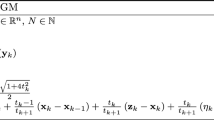Abstract
This paper continues the analysis of approximate inverses from Part I by concentrating on iterative inverses in linear tomographic applications. The importance of differentiating between the ideal resolution of the operator/matrix to be inverted and the actual or effective resolution obtained by the approximate inverse during an iterative procedure is stressed. Means of obtaining the effective resolution operator for standard iterative procedures such as conjugate gradients, Lanczos, and LSQR are provided, while circumventing the usual need to produce a singular-value decomposition of the operator being inverted. The methods discussed produce very simple results in calculations with infinite precision, but require reorthogonalization of the Krylov vectors/operators produced by the iterative procedures in finite precision. Although this need for reorthogonalization increases the expense of the procedure somewhat, it still produces the desired results much more efficiently than what could be obtained using a full singular-value decomposition of the operator.
Similar content being viewed by others
References
W. E. Arnoldi, “The principle of minimized iterations in the solution of the matrix eigenvalue problem,” Quart. Appl. Math. vol. 9, pp. 17-29, 1951.
S. F. Ashby, T. A. Manteuffel, and P. E. Saylor, “A taxonomy for conjugate gradient methods,” SIAM J. Numer. Anal. vol. 27, pp. 1542-1568, 1990.
J. G. Berryman, “Stable iterative reconstruction algorithm for nonlinear travel-time tomography,” Inverse Problems vol. 6, pp. 21-42, 1990.
J. G. Berryman, “Resolution of iterative inverses in seismic tomography,” in Proceedings of the Cornelius Lanczos International Centenary Conference, J. D. Brown, M. T. Chu, D. C. Ellison, and R. J. Plemmons, eds., North Carolina State University, Raleigh, NC, Dec. 12-17, 1993 (SIAM: Philadelphia, PA), pp. 297-299, 1994a.
J. G. Berryman, “Tomographic resolution without singular value decomposition,” in Mathematical Methods in Geophysical Imaging II, S. Hassanzadeh, ed., Proceedings of SPIE, vol. 2301, July 24-29, 1994, San Diego, CA (SPIE: Bellingham, Washington), pp. 2-13, 1994b.
J. G. Berryman, “Analysis of approximate inverses in tomography. I. Resolution analysis of common inverses,” Optimization and Engineering vol. 1, pp. 87-115, 2000.
J. G. Berryman, and S. Fomel, “Iterative methods of optimization with application to crosswell tomography,” Stanford Exploration Project vol. SEP-93, pp. 109-132, 1996.
J. G. Berryman, and M. A. Saunders, in preparation.
A. Björck, and T. Elfving, “Accelerated projection methods for computing pseudoinverse solutions of systems of linear equations,” BIT vol. 19, pp. 145-163, 1979.
J. E. Craig, “The N-step iteration procedures,” J. Math. and Phys. vol. 34, pp. 64-73, 1955.
K. A. Dines and R. J. Lytle, “Computerized geophysical tomography,” Proc. IEEE vol. 67, pp. 1065-1073, 1979.
J. R. Evans and U. Achauer, “Teleseismic velocity tomography using the ACH method: Theory and application to continental-scale studies,” in Seismic Tomography: Theory and Practice, H. M. Iyer and K. Hirahara, eds., Chapman and Hall: London, pp. 319-360, 1993.
R. Fletcher and C. M. Reeves, “Function minimization by conjugate gradients,” Computer Journal vol. 7, pp. 149-154, 1964.
S. Fomel, “Least-square inversion with inexact adjoints, method of conjugate direction: a tutorial,” Stanford Exploration Project, vol. SEP-92, pp. 253-265, 1996.
P. Gilbert, “Iterative methods for the three-dimensional reconstruction of an object from projections,” J. Theor. Biol. vol. 36, pp. 105-117, 1972.
G. R. Goldstein and J. A. Goldstein, “The best generalized inverse,” J. Math. Anal. Appl. vol. 252, pp. 91-101, 2000.
G. Golub and W. Kahan, “Calculating the singular values and pseudo-inverse of a matrix,” SIAM J. Numer. Anal. vol. 2, pp. 205-224, 1965.
G. H. Golub and C. F. Van Loan, Matrix Computations, Johns Hopkins University Press: Baltimore, p. 341, 1989.
A. Greenbaum and Z. Strakos, “Predicting the behavior of finite precision Lanczos and conjugate gradient computations,” SIAM J. Matrix Anal. vol. 13, pp. 121-137, 1992.
M. R. Hestenes and E. Stiefel, “Methods of conjugate gradients for solving linear systems,” J. Res. Nat. Bur. Stan. vol. B 49, pp. 409-436, 1952.
S. Ivansson, “Remark on an earlier iterative tomographic algorithm,” Geophys. J. R. Astr. Soc. vol. 75, pp. 855-860, 1983.
C. Lanczos, “An iterative method for the solution of the eigenvalue problem of linear differential and integral operators,” J. Res. Nat. Bur. Stand. vol. 45, pp. 255-282, 1950.
D. G. Luenberger, Introduction to Linear and Nonlinear Programming, Addison-Wesley: Reading Massachusetts, Ch. 7 and 8, pp. 148-155, 168-186, 1973.
S. E. Minkoff, “A computationally feasible approximate resolution matrix for seismic inverse problems,” Geophys. J. Int. vol. 126, pp. 345-359, 1996.
C. C. Paige and M. A. Saunders, “LSQR: An algorithm for sparse linear equations and sparse least squares,” ACM Trans. Math. Softw. vol. 8, pp. 43-71, 1982.
M. A. Saunders, “Solution of sparse rectangular systems using LSQR and Craig,” BIT vol. 35, pp. 588-604, 1995.
M. A. Saunders, “Computing projections with LSQR,” BIT vol. 37, pp. 96-104, 1997.
A. van der Sluis and H. A. van der Vorst, “Numerical solution of large, sparse linear algebraic systems arising from tomographic problems,” in Seismic Tomogrpahy-With Applications in Global Seismology and Exploration Geophysics, G. Nolet, ed., Reidel: Dordrecht, Holland, Ch. 3, pp. 49-83, 1987.
A. van der Sluis and H. A. van der Vorst, “SIRT-and CG-type methods for the iterative solution of sparse linear least-squares problems,” Linear Algebra Appl. vol. 130, pp. 257-302, 1990.
R. S. Varga, Matrix Iterative Analysis, Prentice-Hall: Englewood, Cliffs, NJ, pp. 16, 17, 141, 159, 1962.
D. W. Vasco, J. E. Peterson, Jr., and E. L. Majer, “Nonuniqueness in traveltime tomography: Ensemble inference and cluster analysis,” Geophysics vol. 61, pp. 1209-1227, 1996.
J. Zhang and G. A. McMechan, “Estimation of resolution and covariance for large matrix inversions,” Geophys. J. Int. vol. 121, pp. 409-426, 1995.
Author information
Authors and Affiliations
Rights and permissions
About this article
Cite this article
Berryman, J.G. Analysis of Approximate Inverses in Tomography II. Iterative Inverses. Optimization and Engineering 1, 437–473 (2000). https://doi.org/10.1023/A:1011588308111
Published:
Issue Date:
DOI: https://doi.org/10.1023/A:1011588308111




